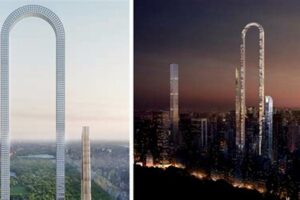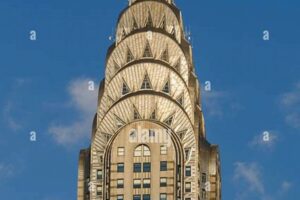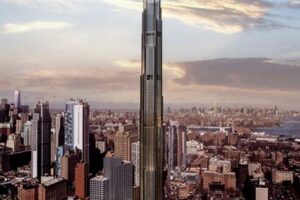When it comes to iconic cityscapes, few can rival the breathtaking skyline of New York City. A defining feature of this urban panorama is the abundance of towering skyscrapers, each a testament to architectural innovation and engineering prowess. The New York skyscraper view is a sight to behold, a captivating blend of modern marvels and historical landmarks that has become synonymous with the city’s identity.
The rise of skyscrapers in New York City can be traced back to the late 19th century, with the construction of the Flatiron Building in 1902 marking a pivotal moment. Since then, the city has witnessed a continuous upward trajectory in the construction of these vertical giants, with each new addition pushing the boundaries of design and height. Today, the New York skyline boasts some of the world’s tallest and most iconic skyscrapers, including the Empire State Building, the Chrysler Building, and One World Trade Center.
The New York skyscraper view is not merely a visual spectacle; it also holds immense cultural and economic significance. These towering structures have become symbols of the city’s ambition, innovation, and global influence. They serve as landmarks for navigation, provide unparalleled views for residents and visitors alike, and house a vast array of businesses, offices, and residential units. Furthermore, the construction and maintenance of skyscrapers generate significant employment opportunities, contributing to the city’s economic vitality.
1. Height
The height of New York City’s skyscrapers is a defining characteristic of the city’s skyline and a major contributing factor to the iconic New York skyscraper view. These towering structures not only dominate the cityscape but also offer unparalleled views of the city and beyond. Visitors and residents alike can ascend to observation decks located high above the streets, providing breathtaking panoramas that showcase the city’s vastness and architectural diversity.
- Record-Breaking Heights: New York City has been home to some of the world’s tallest buildings throughout history, including the Empire State Building, which held the title of world’s tallest building from 1931 to 1972. Today, One World Trade Center stands as the tallest building in the Western Hemisphere and the sixth tallest in the world.
- Architectural Innovation: The pursuit of height in New York City has driven architectural innovation, leading to the development of new construction techniques and materials. For example, the Empire State Building’s steel frame design allowed it to reach unprecedented heights at the time of its construction.
- Urban Planning: The presence of tall skyscrapers has influenced urban planning in New York City. Zoning laws and regulations have been implemented to manage the height and density of buildings, ensuring that the city’s skyline remains balanced and aesthetically pleasing.
- Economic Impact: The construction and maintenance of skyscrapers generate significant economic activity. These projects create jobs in architecture, engineering, construction, and related industries.
In conclusion, the height of New York City’s skyscrapers is an integral part of the city’s identity and contributes to its iconic skyline. These towering structures represent architectural innovation, urban planning, and economic vitality, all of which shape the unique experience of the New York skyscraper view.
2. Architecture
The diverse range of architectural styles exhibited by New York City’s skyscrapers is an integral component of the iconic New York skyscraper view. These architectural styles, spanning from Art Deco to Modernist to Postmodern, contribute to the city’s unique and captivating skyline while reflecting the evolution of architectural trends and technological advancements.
The Art Deco style, popular in the 1920s and 1930s, is characterized by its geometric forms, stylized ornamentation, and sleek lines. The Chrysler Building and the Empire State Building are notable examples of Art Deco skyscrapers that have become symbols of the New York skyline. Modernist skyscrapers, prevalent in the mid-20th century, emphasize simplicity, functionality, and the use of glass and steel. The Seagram Building and Lever House are iconic examples of Modernist architecture in New York City, showcasing the influence of the International Style.
Postmodern skyscrapers emerged in the late 20th century, challenging the simplicity of Modernist architecture with a playful and eclectic approach. Buildings like the AT&T Building (now known as 550 Madison Avenue) and the Trump Tower exemplify the Postmodern style, incorporating historical references, bold colors, and unconventional shapes. The postmodern movement sought to create visually striking and engaging structures that break away from the perceived monotony of Modernist architecture.
The diversity of architectural styles in New York City’s skyscrapers not only contributes to the city’s visual appeal but also reflects the city’s cultural and historical evolution. These buildings are not just functional structures but also works of art that embody the aspirations and creativity of their time. Understanding the connection between architectural styles and the New York skyscraper view enhances our appreciation of the city’s built environment and its enduring legacy.
3. Engineering
The engineering behind New York City’s skyscrapers is a crucial element in creating the iconic New York skyscraper view. The construction of these towering structures requires innovative engineering solutions to overcome challenges posed by height, wind, and seismic activity. Engineers and architects must work together to design buildings that are both structurally sound and visually appealing.
One of the most important engineering considerations for skyscrapers is the structural system. The structural system must be able to withstand the weight of the building, as well as lateral forces such as wind and earthquakes. Engineers use a variety of structural systems, including braced frames, moment frames, and shear walls, to ensure that buildings can resist these forces and remain standing.
Another important engineering consideration is the building’s foundation. The foundation must be able to support the weight of the building and transfer the load to the underlying soil or rock. Engineers must carefully design the foundation to prevent the building from sinking or settling unevenly.
The engineering of New York City’s skyscrapers is a complex and challenging task, but it is essential for creating the iconic New York skyscraper view. Engineers
and architects must work together to design buildings that are both structurally sound and visually appealing. These buildings are a testament to the ingenuity and skill of the engineers and architects who designed and built them.
4. Views
The breathtaking views offered by New York City’s skyscrapers are an integral component of the iconic New York skyscraper view. Ascending to the observation decks of these towering structures provides visitors and residents alike with unparalleled vistas that extend far beyond the city’s bustling streets.
- Panoramic Perspectives: Skyscrapers offer a unique vantage point to take in the city’s vastness and diversity. From Central Park’s lush greenery to the shimmering waters of the Hudson River, the panoramic views from these elevated perspectives capture the essence of New York City’s urban fabric and natural beauty.
- Architectural Appreciation: The New York skyscraper view also provides an opportunity to appreciate the city’s architectural landmarks from a different angle. Gazing out from observation decks, visitors can admire the intricate details and distinct silhouettes of iconic buildings, such as the Empire State Building, the Chrysler Building, and the One World Trade Center.
- Geographical Orientation: The panoramic views from skyscrapers serve as a valuable tool for geographical orientation. By identifying landmarks and tracing the flow of major thoroughfares, visitors can gain a deeper understanding of the city’s layout and its relationship to surrounding areas.
- Inspiration and Reflection: The New York skyscraper view has a profound impact on the human experience. The expansive vistas inspire awe and wonder, while also providing a space for reflection and contemplation. The city’s skyline, constantly evolving and yet timeless, serves as a reminder of human ambition and creativity.
In conclusion, the views offered by New York City’s skyscrapers are not merely visual spectacles but also contribute to the city’s cultural and experiential landscape. These unparalleled vistas enhance our appreciation of the city’s architectural heritage, provide a unique perspective on its geography, and inspire a sense of wonder and reflection.
5. Landmarks
The iconic skyscrapers of New York City are not just architectural marvels but also beloved landmarks that contribute significantly to the city’s identity and global recognition. These landmarks play a pivotal role in shaping the “New York skyscraper view” and enhancing its cultural and experiential significance.
The presence of iconic landmarks within the New York skyscraper view has several important effects:
- Recognition and Identity: Iconic skyscrapers, such as the Empire State Building, the Chrysler Building, and One World Trade Center, are instantly recognizable symbols of New York City. Their distinctive silhouettes and architectural features make them easily identifiable, contributing to the city’s unique visual identity and global recognition.
- Cultural Significance: Many of New York City’s skyscrapers have become deeply embedded in the city’s culture and history. They serve as backdrops for countless films, television shows, and other cultural productions, reinforcing their iconic status and emotional resonance with people worldwide.
- Tourist Attractions: Iconic skyscrapers are major tourist attractions, drawing visitors from around the globe who come to witness these architectural wonders firsthand. Observation decks, such as the Top of the Rock and the One World Observatory, offer breathtaking views of the city and its landmarks, further enhancing the appeal of the New York skyscraper view.
Understanding the connection between landmarks and the New York skyscraper view is essential for appreciating the city’s architectural heritage and its significance in popular culture. These iconic landmarks not only define the city’s skyline but also contribute to its global appeal and enduring legacy.
6. Business
The bustling activity within New York City’s skyscrapers is an integral part of the iconic “New York skyscraper view.” These towering structures are not just architectural wonders but also hives of economic activity, housing a diverse range of businesses and offices that contribute significantly to the city’s economic vitality.
- Corporate Headquarters: Many of the world’s largest and most influential corporations have their headquarters in New York City skyscrapers, including financial institutions, technology giants, and media companies. These corporate headquarters play a crucial role in shaping the city’s economic landscape and global financial markets.
- Professional Services: Skyscrapers in New York City are also home to a multitude of professional services firms, such as law firms, accounting firms, and consulting firms. These firms provide essential services to businesses and individuals, contributing to the city’s reputation as a global center for commerce and finance.
- Tech Hubs: In recent years, New York City has emerged as a major tech hub, with many tech startups and established tech companies setting up offices in the city’s skyscrapers. This influx of tech companies has further boosted the city’s economy and created a vibrant innovation ecosystem.
- Tourism and Hospitality: The iconic skyscrapers of New York City also contribute to the city’s tourism industry. Observation decks, such as the Top of the Rock and the One World Observatory, offer breathtaking views of the city and attract millions of tourists each year. Additionally, many skyscrapers house luxury hotels and restaurants, catering to both business travelers and tourists alike.
The economic activity generated by businesses and offices in New York City skyscrapers has a ripple effect throughout the city’s economy, supporting countless jobs and industries. The presence of these businesses also contributes to the city’s vibrant street life and urban culture, making it a dynamic and exciting place to live, work, and visit.
7. Tourism
The iconic New York skyscraper view has become a major tourist attraction, drawing visitors from around the globe who come to witness the city’s architectural marvels and experience its vibrant urban culture. The connection between tourism and the New York skyscraper view is mutually beneficial, as the skyscrapers contribute to the city’s appeal as a tourist destination, while tourism supports the businesses and economy that occupy these towering structures.
- Landmark Recognition: Visitors to New York City are eager to see the city’s iconic skyscrapers, such as the Empire State Building, the Chrysler Building, and One World Trade Center, which have been featured in countless movies, television shows, and other cultural productions. These landmarks
are instantly recognizable symbols of the city and a major draw for tourists. - Observation Decks: Many skyscrapers in New York City offer observation decks that provide breathtaking views of the city’s skyline and surrounding areas. These observation decks, such as the Top of the Rock and the One World Observatory, offer a unique perspective on the city and are a popular attraction for tourists and locals alike
- Architectural Appreciation: The New York skyscraper view showcases the city’s architectural heritage and diversity, from the Art Deco masterpieces of the early 20th century to the modern glass and steel towers of today. Visitors can admire the intricate details and distinct silhouettes of these iconic buildings, gaining a deeper appreciation for the city’s architectural legacy.
- Urban Culture: The New York skyscraper view is not just about the buildings themselves but also about the vibrant urban culture that surrounds them. Tourists can experience the city’s bustling streets, world-class dining, and cultural attractions, all while being surrounded by the iconic skyscrapers that define the city’s skyline.
In conclusion, the connection between tourism and the New York skyscraper view is a mutually beneficial one. The iconic skyscrapers contribute to the city’s appeal as a tourist destination, while tourism supports the businesses and economy that occupy these towering structures. The New York skyscraper view is not just a visual spectacle but also a major economic and cultural asset for the city.
8. Culture
The connection between culture and the New York skyscraper view is profound and multifaceted. Skyscrapers have become iconic symbols of the city’s ambition, innovation, and global influence, shaping its cultural identity and contributing to its allure as a tourist destination. Understanding this cultural significance enhances our appreciation of the New York skyscraper view and its role in shaping the city’s narrative.
Skyscrapers embody the city’s relentless drive for progress and innovation. Their soaring heights and cutting-edge designs reflect the ambition and ingenuity of the architects and engineers who conceived them. The Empire State Building, completed in 1931, was once the tallest building in the world and remains a testament to the city’s unyielding spirit of innovation. The Chrysler Building, with its Art Deco ornamentation and distinctive spire, exemplifies the city’s embrace of modernism and its pursuit of architectural excellence.
Beyond their architectural significance, skyscrapers have become cultural landmarks, deeply embedded in the city’s identity. They serve as backdrops for countless films, television shows, and works of literature, reinforcing their iconic status and emotional resonance with people worldwide. The Empire State Building, in particular, has become a beloved symbol of the city, featured prominently in popular culture and serving as a beacon of hope and resilience.
The cultural significance of the New York skyscraper view extends beyond the individual buildings themselves. It encompasses the entire skyline, a mesmerizing tapestry of architectural styles and urban density that has come to define the city’s visual identity. The skyline is a constant source of inspiration for artists, photographers, and filmmakers, capturing the essence of the city’s energy and ambition.
In conclusion, the connection between culture and the New York skyscraper view is undeniable. Skyscrapers have become symbols of the city’s ambition, innovation, and global influence, shaping its cultural identity and contributing to its allure as a tourist destination. Understanding this cultural significance enhances our appreciation of the New York skyscraper view and its role in shaping the city’s narrative.
FAQs
This section addresses frequently asked questions and misconceptions surrounding the iconic New York skyscraper view, providing concise and informative answers.
Question 1: What are the tallest buildings in New York City?
One World Trade Center, Central Park Tower, and 111 West 57th Street currently hold the title of the three tallest buildings in New York City, standing at 1,776 feet, 1,550 feet, and 1,428 feet respectively.
Question 2: What is the history behind the iconic New York skyscraper view?
The rise of skyscrapers in New York City began in the late 19th century with the construction of the Flatiron Building in 1902. Since then, the city has witnessed a continuous upward trajectory in the construction of these vertical giants, with each new addition pushing the boundaries of design and height.
Question 3: What is the significance of the New York skyscraper view?
The New York skyscraper view is not merely a visual spectacle; it also holds immense cultural and economic significance. These towering structures have become symbols of the city’s ambition, innovation, and global influence. They serve as landmarks for navigation, provide unparalleled views for residents and visitors alike, and house a vast array of businesses, offices, and residential units.
Question 4: What are the different architectural styles showcased in the New York skyscraper view?
The New York skyscraper view exhibits a diverse range of architectural styles, including Art Deco, Modernist, and Postmodern. Art Deco skyscrapers, popular in the 1920s and 1930s, are characterized by their geometric forms, stylized ornamentation, and sleek lines. Modernist skyscrapers, prevalent in the mid-20th century, emphasize simplicity, functionality, and the use of glass and steel. Postmodern skyscrapers emerged in the late 20th century, challenging the simplicity of Modernist architecture with a playful and eclectic approach.
Question 5: What are the challenges faced in constructing and maintaining skyscrapers in New York City?
The construction and maintenance of skyscrapers in New York City present significant engineering challenges, primarily due to the city’s dense urban environment, limited space, and seismic activity. Engineers and architects must carefully consider factors such as structural stability, wind resistance, and foundation design to ensure the safety and longevity of these towering structures.
Question 6: How does the New York skyscraper view contribute to the city’s economy?
The construction and maintenance of skyscrapers in New York City generate substantial economic activity. These projects create jobs in architecture, engineering, construction, and related industries, contributing to the city’s overall economic vitality. Additionally, skyscrapers house a multitude of businesses, offices, and retail spaces, further stimulating the local economy.
In summary, the New York skyscraper view is a captivating blend of architectural marvels and cultural significance. Understanding the history, engineering challenges, and economic impact behind these iconic structures enhances our appreciation for the city’s skyline and its enduring legacy.
Transition to the next article section:
Explore the breathtaking views, iconic landmarks, and cultural significance of the New York skyscraper view in greater detail in the following sections.
Tips for Enhancing Your Experience of the New York Skyscraper View
To fully appreciate the iconic New York skyscraper view, consider incorporating the following tips into your exploration:
Tip 1: Choose Strategic Observation Points
For breathtaking panoramic vistas, as
cend to the observation decks of renowned skyscrapers like the Empire State Building, Top of the Rock, or One World Observatory. These vantage points offer unparalleled 360-degree views of the city’s skyline and surrounding landmarks.
Tip 2: Explore Different Times of Day
The New York skyscraper view transforms throughout the day. Visit observation decks during sunrise, sunset, and nighttime hours to capture the city’s varying moods and lighting conditions, each offering a unique and unforgettable experience.
Tip 3: Take Advantage of Architectural Tours
Delve deeper into the architectural marvels of New York City’s skyscrapers by participating in guided tours. Learn about the design concepts, engineering challenges, and historical significance of these iconic structures, enriching your appreciation for their grandeur.
Tip 4: Capture the Skyline from Multiple Perspectives
Don’t limit yourself to observation decks alone. Explore the city streets and waterfront areas to capture the skyscraper view from different angles. Take advantage of parks like Battery Park or Brooklyn Bridge Park for stunning ground-level perspectives.
Tip 5: Discover Lesser-Known Gems
Venture beyond the popular observation decks to uncover hidden gems that offer equally captivating views. Consider visiting the SUMMIT One Vanderbilt or The Edge at Hudson Yards for unique experiences and less crowded vantage points.
Tip 6: Plan Your Visit During Off-Peak Hours
To avoid excessive crowds and long wait times, plan your visit to observation decks during off-peak hours, such as early mornings or late evenings. This will allow you to fully immerse yourself in the breathtaking views without distractions.
Tip 7: Enhance Your Knowledge
Before your visit, take some time to research the history and architecture of New York City’s skyscrapers. This will enhance your appreciation for the ingenuity and craftsmanship that went into creating these urban giants.
Summary:
By incorporating these tips into your exploration, you can elevate your experience of the New York skyscraper view. From strategic observation points to architectural insights and unique perspectives, these recommendations will help you capture the grandeur and beauty of this iconic cityscape.
Conclusion
The exploration of the New York skyscraper view has illuminated its multifaceted significance, encompassing architectural marvels, cultural icons, and economic powerhouses. These towering structures have shaped the city’s identity, providing breathtaking vistas and serving as symbols of innovation and ambition.
As the city continues to evolve, the New York skyscraper view will undoubtedly undergo transformations, with new architectural wonders gracing the skyline. Yet, the enduring legacy of these iconic structures lies in their ability to inspire, captivate, and connect people from all walks of life. Whether admired from observation decks, captured through photography, or simply enjoyed as part of the urban landscape, the New York skyscraper view remains a testament to human ingenuity and the ever-changing face of one of the world’s most vibrant metropolises.







